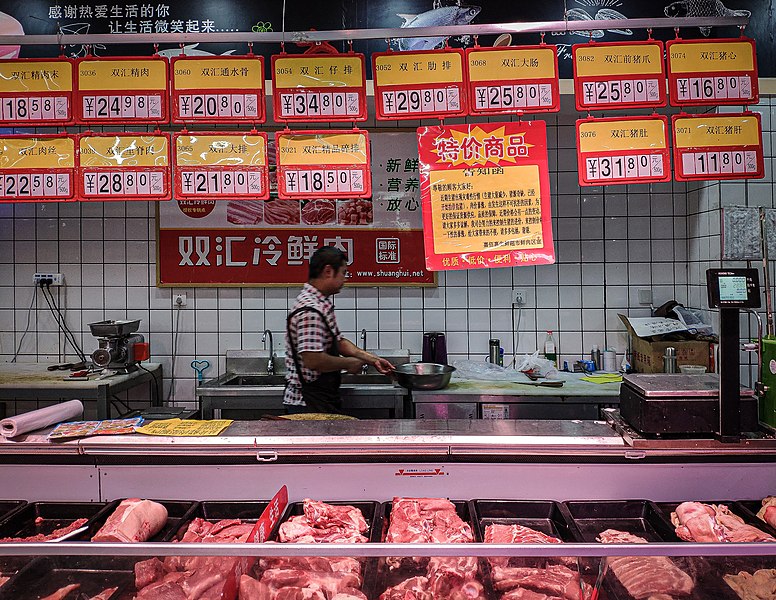
China’s African Swine Fever Now Global Threat
By F. William Engdahl
30 November 2019
Image credits: SCJiang - 中文(中国大陆): 非洲猪瘟时期中国的一处肉类市场,猪肉价格走高,市场张贴相关说明. License: This file is licensed under the Creative Commons Attribution-Share Alike 4.0 International license with some rights reserved https://bit.ly/2XZ7R4A
The worst outbreak of fatal African Swine Fever disease ever has devastated the world’s largest pig population, that of China, over the past months. Now it is spreading to neighboring states and even threatens the United States pig herds. The political and human impact could be far worse than imagined as a de facto pandemic disease situation spreads. Globalization of agribusiness is not helping matters.
.
The worst outbreak of fatal African Swine Fever disease ever has devastated the world’s largest pig population, that of China, over the past months. Now it is spreading to neighboring states and even threatens the United States pig herds. The political and human impact could be far worse than imagined as a de facto pandemic disease situation spreads. Globalization of agribusiness is not helping matters.
On August 3, 2018 a case of African Swine Fever (ASF) was confirmed in China’s Liaoning Province. Since then despite various measures to contain the deadly disease it has spread across China where as of November, 2019 in little more than a year, nearly half of China’s huge pig population has either died or been eliminated in a desperate effort to contain the disease. ASF is not deadly to humans but is 100% fatal to any pig that is infected. There is no known treatment to cure it. It can be spread by direct contact with an infected pig, body fluids, contact with equipment or clothing and via certain tick species.
The China Agriculture Ministry issued a report in August that the size of China’s live pig herd had declined by a very precise 38.7% from August 2018. Industry sources suspect underreporting and put the actual number at more like 50%. In any event it is huge, and has impacted the politically sensitive measure of China food price inflation over the past year. Pork is a mainstay of the Chinese diet for meat protein and considered a national security issue. Most pigs in China are raised by small-scale farmers who face ruin now. According to reports inside China this has led many desperate small farmers to try to hide the presence of ASF in their herds, to slaughter and sell, to avoid financial ruin.
The disease is especially dangerous. According to experts it’s hard to kill. One report notes, “It lives in feces for 11 days and blood for 15 weeks. It lives in salted meat for 182 days, dried meat for almost a year, and frozen meat for three years. The Chinese love to take meat snacks with them when they travel. Rules can be bent in Asia.”
Even more alarming are reports that disposal of infected China pig carcasses is not safe. Rather than treating the infected dead pigs as biohazard and burying them far from the farm site the proper way burning them and treat the site as hazardous waste for a year or more, covering the site with lime, it has been documented that often small farmers bury the pigs next to the barn with no burning. That risks renewed outbreak of the disease .
China had the world’s largest pig population at the beginning of 2018 with a population that was 440 million strong, out of a global population estimated at 769 million pigs. Now it could be down half of that, a major shock to world meat protein supplies.
The speed of the spread of the disease across all China has clearly overtaxed the system there. However despite assurances, the spread has not been contained inside China.
Spreading globally
The ASF disease is spreading outside China as well. The Wall Street Journal noted, “In recent months, customs officials in Japan, Taiwan and Australia have found infected meat in other food products carried by tourists. And the disease has since been confirmed in herds in Vietnam, Mongolia and Cambodia.” The UN Food and Agriculture Organization (FAO) reports that all provinces in Vietnam have reported ASF outbreaks and that more than 5,880,000 pigs have been culled since the first case was discovered in February.
From China the ASF disease has also spread to North Korea. From there contagious pigs have crossed the buffer zone to South Korea necessitating severe measures from South Korea, according to Ahn Chan-il, leader of World Institute for North Korea Studies and a former North Korean service member.
According to the FAO, as of November 21 significant African Swine Fever cases among pig populations in The Philippines, Laos and Timor Leste have also been documented. And wild boars carrying the disease have been detected at the border region in Russia with Mongolia. In several instances ASF virus gene was detected in pork products confiscated at Incheon Airport in Seoul South Korea brought by passengers from Shenyang City, China, an indication of how difficult containment is.
Isolated cases have also been detected in EU countries including Bulgaria, Romania, and Hungary which are acting swiftly to contain spread. It has also been documented in Moldavia, Belarus and Ukraine. Most recently, cases of the ASF have been detected in Poland not far from the German border. In early November African Swine Fever was found in 20 wild boar in Poland’s western Lubusz province near the Oder River, some 80 kilometers east of Germany, the European Union’s biggest hog producer.
An alarming case was discovered over several weeks in March of a Chinese ship container at a port in Newark, New Jersey where Federal agents seized 1 million pounds of pork smuggled from China, the largest-ever U.S. seizure of agricultural products. The pork was hidden in containers of ramen noodles and laundry detergent. Authorities took it to determine if it was contaminated with ASF.
There are many unanswered questions at this point about African Swine Fever pandemic spread. What is clear is that this is far more dangerous than we have so far been led to believe. In October, according to a new report by Henry Kamens, seven dead wild boar washed ashore in Denmark, a major pig producer country, and were disposed of without even being tested for ASF.
F. William Engdahl is strategic risk consultant and lecturer, he holds a degree in politics from Princeton University and is a best-selling author on oil and geopolitics, exclusively for the online magazine “New Eastern Outlook”
